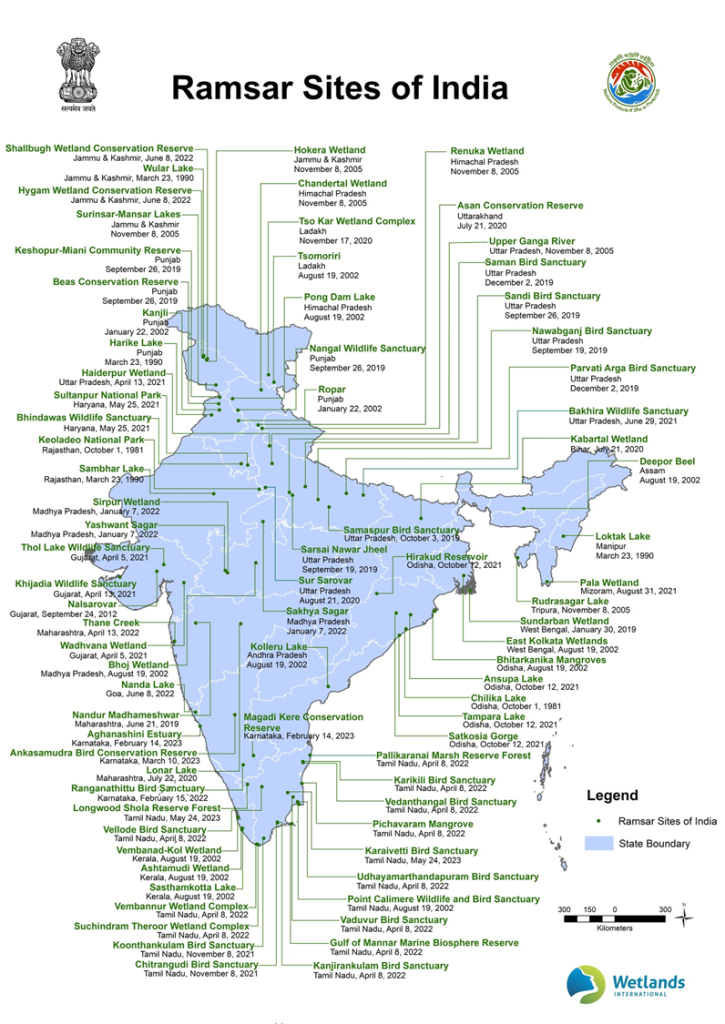Wetlands are vital for human survival. They are among the world’s most productive environments; cradles of biological diversity that provide the water and productivity upon which countless species of plants and animals depend for survival.
AFCAT 1 2025 Exam Static GK Ramsar & Lakes In India
Union Environment Minister Bhupender Yadav announced three new Ramsar sites in Tamil Nadu and Madhya Pradesh earlier this month, taking the total of such sites in India to 85. The new additions are the Nanjarayan Bird Sanctuary and the Kazhuveli Bird Sanctuary in Tamil Nadu, and the Tawa Reservoir in Madhya Pradesh.
What are Ramsar sites?
The Ramsar Convention is an intergovernmental treaty signed in 1971 in Ramsar, Iran. It encourages the protection and conservation of wetlands worldwide by designating them as such.
The selection of Ramsar sites is based on various criteria defined under the convention. For example, “A wetland should be considered internationally important if it supports plant and/or animal species at a critical stage in their life cycles, or provides refuge during adverse conditions.” It also looks at the sites’ capacity to support fishes and waterbirds.
Organisations like the International Union for Conservation of Nature, the World Wide Fund for Nature, and other environmental agencies are associated with the treaty.
It also has 172 signatory countries. They are obligated to create wetland reserves and promote the wise use of wetland habitats. India joined it in 1982, initially designating the Chilika Lake in Orissa and Keoladeo National Park in Rajasthan. Today, the country has among the highest number of Ramsar sites in Asia.
The Sundarbans is one of the most renowned wetlands in India. Cold desert ecosystems also have wetlands, like the Tso Moriri. The Pangong Tso in Ladakh, which include rare and endangered species such as the black-necked crane, is also in the process of being identified as a Ramsar site.
What are the new Ramsar sites?
The Nanjarayan Bird Sanctuary in Tamil Nadu is located on the banks of river Noyyal. Originally a water reservoir for irrigation use, it has since become a significant ecosystem, supporting a varied range of avifauna.
Home to species like the Eurasian coot, spot-billed duck and many types of herons, the wetland also serves various migratory birds flying along the Central Asian Highway, establishing itself as a biodiversity hotspot. It also contributes to the locals’ livelihood through fishing.
The Kazhuveli Sanctuary on the Coromandel Coast is one of the largest brackish water wetlands in south India. The ecosystem’s mix of salt marshes, mudflats and shallow waters make it a home to many globally endangered species, like the black-headed ibis and greater flamingo. It is also a stopover for migratory birds along the East Asian-Australasian Flyway. In storing water, Kazhuveli also helps with flood control and groundwater recharge, helping maintain the region’s water table.
The Tawa Reservoir in Madhya Pradesh is also integral in regional water management. Created by damming the Tawa River, the reservoir became a massive wintering ground for migratory birds. Tawa provides irrigation water to farmlands, drinking water to local communities, and sustains the nearby fisheries.
Recent Developments in Wetland Conservation in India
- Wetlands of India Portal: Launched on October 2, 2021, by the Ministry of Environment, Forest, and Climate Change (MoEFCC), this portal provides comprehensive information on India’s wetlands. It includes capacity-building materials, data repositories, and dashboards for each state and union territory.
- National Wetland Decadal Change Atlas: Prepared by the Space Applications Centre (SAC), Ahmedabad, this atlas highlights the changes in wetlands across the country over the past decade.
- Centre for Wetland Conservation and Management (CWCM): Established on World Wetland Day 2021, this center focuses on addressing research needs and knowledge gaps in wetland conservation.
- Wetlands Rejuvenation Programme: Initiated by MoEFCC in 2020, this program aims to rejuvenate over 500 wetlands across India. It includes developing baseline information, rapid assessments, stakeholder engagement, and management planning.
- Integration with River Basin Management: The Namami Gange program integrates wetland conservation with river basin management, serving as a model framework for the entire country.
- National Plan for Conservation of Aquatic Ecosystems: In 2013, the National Wetlands Conservation Programme and the National Lake Conservation Plan were combined to create the National Plan for Conservation of Aquatic Ecosystems. This comprehensive plan reflects a holistic government approach to protecting vital aquatic ecosystems.
- Amrit Dharohar Scheme: Launched with the Union Budget 2023-24, the Amrit Dharohar Scheme is a key initiative aimed at optimizing wetland utilization over the next three years. Its goals include enhancing biodiversity, increasing carbon stock, boosting eco-tourism, and generating income for local communities, in line with the government’s sustainable development vision.
- MoEFCC’s Wetlands Rejuvenation Programme: Launched in 2020, the Ministry of Environment, Forest & Climate Change (MoEFCC) initiated the Wetlands Rejuvenation Programme. This multifaceted approach includes developing baseline data, assessing wetland health, establishing stakeholder platforms, and creating comprehensive management plans. The program covers over 500 wetlands, showcasing the government’s dedication to conserving these essential habitats.
- National Wildlife Action Plan: The National Wildlife Action Plan (2017-2031) emphasizes the conservation of inland aquatic ecosystems, including wetlands. It advocates for a national wetlands mission to preserve these habitats, recognizing their importance for biodiversity and ecosystem services.
- Integration with Namami Gange: On World Wetlands Day 2021, the Ministry of Jal Shakti highlighted the integration of wetland conservation with the Namami Gange program. The National Mission for Clean Ganga (NMCG) has pioneered initiatives that serve as models for wetland conservation nationwide.























